Panda Village Chinese Restaurant ( 11:30 a.m.–9 p.m. Mon.–Thurs., 11:30 a.m.–10 p.m. Fri. and Sat., US$5–8) has dependable Chinese food with chicken, fish, and shrimp dishes.

Call or email for assistance planning your trip: +1 (212) 203-0064 | reservations@moonjamaica.com
Panda Village Chinese Restaurant ( 11:30 a.m.–9 p.m. Mon.–Thurs., 11:30 a.m.–10 p.m. Fri. and Sat., US$5–8) has dependable Chinese food with chicken, fish, and shrimp dishes.
Little Tokyo ( 10:30 a.m.–9 p.m. Mon.–Thurs., 10:30 a.m.–10 p.m. Fri.–Sat., noon–7 p.m. Sun.) is a Chinese/Japanese greasy fast-food joint that claims to serve "the best food in town." Best or not, it's relatively affordable (US$5–10).
Dragon Court (11:30 a.m.–9:30 p.m., till 10 p.m. for takeout daily) serves decent Chinese food ranging from chicken dishes (US$7) to lobster (US$29).
Fee Fee Fast Food (7 a.m.–6 p.m. Mon.–Sat., US$3.50–7) has Indian-Caribbean dishes like roti, curry chicken, and curry goat, with red pea soup with beef on Wednesdays and Saturdays, chicken or beef soup with pumpkin on other days. Oxtail and other chicken dishes are also available. Fee Fee delivers all over Kingston (US$1.15–2), down to Cross Roads and up to Manor Park. The breakfast menu changes daily, with porridge and hearty Jamaican dishes like ackee and saltfish, callaloo and cabbage, and stew chicken.
Jewel of India , (noon–10 p.m. daily, reservations recommended) serves North Indian cuisine in an upscale South Beach contemporary atmosphere with Indian Buddha bar music. Dishes range from chicken shorba and tomato soup (US$5) to lamb (US$13), lobster (US$30), tandoori filet mignon (US$28), and masala lamb chops (US$23). The bar has a nice range of liquor and an extensive cocktail menu, including house items Kama Sutra, Indian Sunrise, Indian Smooch, and Vindaloo Margarita. The food can be hit or miss and the expense quickly adds up.
Habibi Latino Restaurant ( 11 a.m.–11 p.m. Mon.–Sat., 3–11 p.m. Sun.) is easily one of Kingston's finest eats. Co-owners Abdul El Khalili and Yani Machado, of Lebanese and Cuban origin respectively, bring together their native cuisines as if they were created for each other, delivering tasty combinations of hummus appetizers, rosemary-seasoned steak, and tostones (fried plantains). A meal for two costs around US$50.
Mango Ranch (10 a.m.–midnight Mon.–Sat., bar open 6 p.m.–midnight Sun.) is a restaurant and pool bar next to a car wash that opened in early 2009. The kitchen serves different items every day, with dishes like curried goat, stew peas, oxtail, escovitch fish, jerk chicken or pork, and fried or stew chicken.manager (Orasha "Dex" Bailey )
Nirvanna Indian Fusion Cuisine (Sun-Wed 11am-3pm for lunch, 6pm-9:30 for dinner, Thurs-Sat 11am-3pm for lunch, 6pm-10:30pm for dinner) is one of the more recent additions to Kingston's Indian food offerings located in a modern plaza just off Hope Road. The restaurant is decidedly high end with a white onyx bar imported from the motherland as its focal point. Booths and table seating cater to groups of various sizes. The menu features traditional Indian dishes as well as Asian fusion and creative renditions of local seafood.
Red Bones Blues Café (noon–11 p.m. Mon.–Fri., 6–11 p.m. Sat., bar menu continues till the last customer leaves) has great albeit pricey food (ranging from US$17 for linguine to US$50 for grilled lobster) and a nice ambience with regular low-key events like fashion shows, poetry readings, and cabaret performances on a cozy stage in the garden. There's live music on Fridays, a world music selector on Thursdays, and poetry on the last Wednesday of every month. A gallery on the property features Jamaican painting, sculpture, ceramics, and textiles.
Mother Earth (8 a.m.–4 p.m. Mon.–Sat., US$4.50–5.50) is an excellent veggie and fish joint owned by Georgia Adams serving pepper pot, fish, red pea, and gungo pea soups and entrees like tofu creole, Chinese veggie steak, veggie mince balls, two-bean stew, ackee and saltfish, and tofu or fish chop suey. Meals are accompanied by roti or rice and peas, pumpkin rice, and calalloo rice. Fresh natural juices (US$2–2.25) include beet root, cane, calalloo, June plum, orange, and papaya.